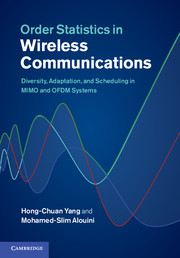 Order Statistics in Wireless Communications
Order Statistics in Wireless Communications 5 - Adaptive transmission and reception
Published online by Cambridge University Press: 07 October 2011
Summary
Introduction
Most conventional diversity techniques target the worst-case scenario [1]. The general principle is to perform a fixed set of combining operations on differently faded replicas such that the combiner output signal exhibits a better quality. This basic design principle manifests itself in the conventional MRC, EGC, and SC schemes as well as those more recent advanced combining schemes discussed in the previous chapter, such as GSC, T-GSC, and GSEC. While this approach has proven to be very effective in improving the performance of wireless communication systems, especially when the channel experiences deep fades, it may lead to an inefficient utilization of the receiver processing resource when the channel becomes more favorable. Note that the same set of combining operations will still be performed even though the system performance may be acceptable with fewer combining operations in this case. This observation motivates the recent interest in adaptive diversity combining for receiver power-saving purposes.
The basic idea of adaptive combining schemes is to adaptively utilize the diversity combiner resource in such a way that the combiner output signal satisfies a certain quality requirement. The generic structure of the adaptive diversity receiver is shown in Fig. 5.1. Specifically, the receiver will just perform enough combining operations such that the quality of the combiner output signal becomes acceptable. For example, minimum selection GSC (MS-GSC) [2–4] is one of the first adaptive combining schemes.
- Type
- Chapter
- Information
- Order Statistics in Wireless CommunicationsDiversity, Adaptation, and Scheduling in MIMO and OFDM Systems, pp. 97 - 161Publisher: Cambridge University PressPrint publication year: 2011


